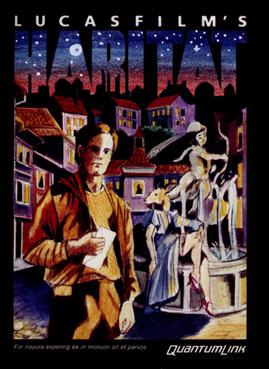
Virtual reality (VR) is a simulated experience that employs pose tracking and 3D near-eye displays to give the user an immersive feel of a virtual world. Applications of virtual reality include entertainment, education and business. Other distinct types of VR-style technology include augmented reality and mixed reality, sometimes referred to as extended reality or XR, although definitions are currently changing due to the nascence of the industry.

VRML is a standard file format for representing 3-dimensional (3D) interactive vector graphics, designed particularly with the World Wide Web in mind. It has been superseded by X3D.
A virtual community is a social network of individuals who connect through specific social media, potentially crossing geographical and political boundaries in order to pursue mutual interests or goals. Some of the most pervasive virtual communities are online communities operating under social networking services.
X3D is a royalty-free ISO/IEC standard for declaratively representing 3D computer graphics. File format support includes XML, ClassicVRML, Compressed Binary Encoding (CBE) and a draft JSON encoding. X3D became the successor to the Virtual Reality Modeling Language (VRML) in 2001. X3D features extensions to VRML, the ability to encode the scene using an XML syntax as well as the Open Inventor-like syntax of VRML97, or binary formatting, and enhanced application programming interfaces (APIs).

A virtual world is a computer-simulated environment which may be populated by many users who can create a personal avatar, and simultaneously and independently explore the virtual world, participate in its activities and communicate with others. These avatars can be textual, graphical representations, or live video avatars with auditory and touch sensations. Virtual worlds are closely related to mirror worlds.

In computing, an avatar is a graphical representation of a user or the user's character or persona. Avatars can be two-dimensional icons in Internet forums and other online communities, where they are also known as profile pictures, userpics, or formerly picons. Alternatively, an avatar can take the form of a three-dimensional model, as used in online worlds and video games.

Habitat is a massively multiplayer online role-playing game (MMORPG) developed by LucasArts. It is the first attempt at a large-scale commercial virtual community that was graphic based. Initially created in 1985 by Randy Farmer, Chip Morningstar, Aric Wilmunder and Janet Hunter the game was made available as a beta test in 1986 by Quantum Link, an online service for the Commodore 64 computer and the corporate progenitor to AOL. Both Farmer and Morningstar were given a First Penguin Award at the 2001 Game Developers Choice Awards for their innovative work on Habitat. As a graphical MUD it is considered a forerunner of modern MMORPGs unlike other online communities of the time. Habitat had a GUI and large user base of consumer-oriented users, and those elements in particular have made Habitat a much-cited project and acknowledged benchmark for the design of today's online communities that incorporate accelerated 3D computer graphics and immersive elements into their environments.

In science fiction, the "metaverse" is a hypothetical iteration of the Internet as a single, universal, and immersive virtual world that is facilitated by the use of virtual reality (VR) and augmented reality (AR) headsets. In colloquial usage, a "metaverse" is a network of 3D virtual worlds focused on social and economic connection.
"A Rape in Cyberspace, or How an Evil Clown, a Haitian Trickster Spirit, Two Wizards, and a Cast of Dozens Turned a Database into a Society" is an article written by freelance journalist Julian Dibbell and first published in The Village Voice in 1993. The article was later included in Dibbell's book My Tiny Life on his LambdaMOO experiences.

Mark D. Pesce is an American-Australian author, researcher, engineer, futurist and teacher.

Seamless3d is an open-source 3D modeling software available under the MIT license.
Web3D was initially the idea to fully display and navigate websites using 3D. By extension, the term now refers to all interactive 3D content that is embedded into web pages' HTML and that users can see through a web browser.
Cyberformance refers to live theatrical performances in which remote participants are enabled to work together in real time through the medium of the internet, employing technologies such as chat applications or purpose-built, multiuser, real-time collaborative software. Cyberformance is also known as online performance, networked performance, telematic performance, and digital theatre; there is as yet no consensus on which term should be preferred, but cyberformance has the advantage of compactness. For example, it is commonly employed by users of the UpStage platform to designate a special type of Performance art activity taking place in a cyber-artistic environment.
Worlds.com, or Worlds Chat, is an online virtual world–based chat program introduced in April 1995 by the company Worlds Inc. Worlds.com was the first program Worlds Inc. made available to the general public, and it was free of charge to download from their website. The popularity of the program, in addition to prior successful developments associated with Worlds Inc. such as Tamiko Thiel's work with Steven Spielberg to create Starbright World, allowed the company to procure a minority investment of $5.6 million from Pearson PLC in June 1995.

Tony Parisi, one of the early pioneers in virtual reality and the metaverse, is an entrepreneur, inventor and developer of 3D computer software. The co-creator of Virtual Reality Modeling Language (VRML), he has written books and papers on the future of technology. He works on WebGL and WebVR and has written two books on the former, and an introductory book on virtual reality programming. He is the chief strategy officer at Lamina1. Parisi is also a musician, composer and producer currently working on multiple projects.

Blaxxun Interactive, originally named "Black Sun Interactive", was one of the first companies to develop a 3D community platform designed for the Internet using VRML and highly scalable multi-user server environments.
Virtual environment software refers to any software, program or system that implements, manages and controls multiple virtual environment instances. The software is installed within an organization's existing IT infrastructure and controlled from within the organization itself. From a central interface, the software creates an interactive and immersive experience for administrators and users.

Nicole Stenger is a French-born American artist, pioneer in virtual reality and Internet movies. In 1989 to 1991, she was a research fellow at MIT. In 1991 to 1992, she was a visiting scholar at the Human Interface Technology Laboratory (Hitlab) in Seattle. Her works have been featured in the SIGGRAPH Art Show, the FILE Festival, the JavaMuseum, the Cartier Art Foundation and are part of the Archive of Digital Art (ADA). In 2013, she was included in the "Contemporary women artists on the web" collection of the National Museum of Women in the Arts, in Washington, D.C. To this day, Stenger is considered to be one of the first artists to explore the artistic virtual reality medium.
VREAM, Inc. was a US technology company that functioned between 1991 and 1996. It was one of the first companies to develop PC-based software for authoring and viewing virtual reality (VR) environments.

SAPARi (さぱり) was an online 3-D virtual world service developed in Java and ran by Sony. Users could speak to one another and join chat lobbies by using a dedicated server browser called the Community Place Browser. Upon selecting a server, users would appear in a 3-D virtual world as an avatar in the form of a human or an animal. The service's name is a shortening of the name Sampo Park Relaxation. From 1997 to 2001, the service came pre-installed on Sony's VAIO series of computers. The official SAPARi service was discontinued on January 31, 2003.











